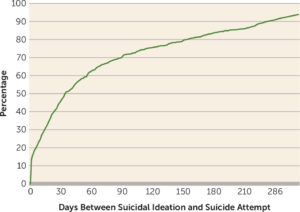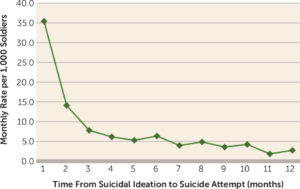New Study Looks at Contributing Factors

Click To Enlarge: Cumulative percent of suicide attempts across days since first documented suicidal ideation among 11,178 active-duty U.S. Army soldiers, 2006–2009
BETHESDA, MD — The statistics are alarming. More soldiers die from self-inflicted gunshot wounds than combat injuries. Eighty-three percent of firearm deaths in the military are from suicide.
While suicide can be or appear to be impulsive, often people contemplate and talk of suicide—suicidal ideation—before actually acting. And while every mention of suicide should be taken seriously, a new study using ARMY STARRS (Study to Assess Risk and Resilience in Servicemembers) data identifies specific factors that may increase the imminent risk among those with suicidal ideation. Recognizing these factors, the researchers say, can enable clinicians and leadership to target interventions.1
To conduct the study, the researchers identified 11,178 active-duty regular Army enlisted soldiers (2006-2009) with medically documented suicidal ideation and no prior medically documented suicide attempts and examined risk factors for suicide attempt within 30 days of first suicidal ideation using logistic regression analyses. Potential risk factors included sociodemographic and service-related characteristics, psychiatric diagnoses, physical health care visits, injuries, and history of family violence or crime perpetration or victimization.
Among soldiers with first documented suicidal ideation, they found, 830 (7.4%) attempted suicide; almost half of those 387 (46.3%) attempted suicide within 30 days. Following a series of multivariate analyses, the final model identified females, combat medics, individuals with an anxiety disorder diagnosis prior to suicidal ideation, and those who received a sleep disorder diagnosis on the same day as the recorded suicidal ideation, as being more likely to attempt suicide within 30 days. Blacks and those who received an anxiety disorder diagnosis on the same day as suicidal ideation were less likely.

Click To Enlarge: Risk of suicide attempt among 11,178 active-duty U.S. Army soldiers following first documented suicidal ideation, 2006–2009
“The most important part of this paper is that it addresses the too often difficult task of the clinician once a patient is diagnosed with suicide ideation—who should I worry about the most?” said author Robert Ursano, MD, director of the Center for the Study of Traumatic Stress at the Uniformed Services University. “The fact that of soldiers with a first diagnosis of suicide ideation who will attempt suicide, half will do so within 30 days, emphasizes the importance of targeted and intensive work with those at highest risk during this 30-day period,” he said. “The findings also highlighted that sleep disorders present at the time of a diagnosis of suicide Ideation is one element that can indicate increased need for intervention and follow up over the following 30 days”.
The research also revealed that just more than half of the soldiers who had documented suicidal thoughts were in their first two years of service, and almost 58% of those had never been deployed—a finding that suggests focusing on soldiers early in their service could potentially offer the greatest impact, Ursano added.
Growing Suicide Risk
Army rates of suicidal behaviors have been historically lower than comparable U.S. general population rates, but in 2008 they surpassed age and gender-matched U.S. civilian rates, said Holly Mash, PhD, research psychologist for The Henry M. Jackson Foundation, working in support of the Center for the Study of Traumatic Stress at the Uniformed Services University.
The following year, Army STARRS was initiated to comprehensively investigate risk factors and protective factors for suicide, suicide-related behavior, and other mental/behavioral health issues in Army soldiers. It is the largest research study of mental health risk and resilience ever conducted among Army personnel. Today, the work of Army STARRS continues with the STARRS-LS (longitudinal study), designed to include longitudinal follow-up studies of more than 72,000 soldiers who participated in Army STARRS.
“A primary focus of the [program] is to identify risk factors for suicidal behaviors in order to provide actionable recommendations to the U.S. Army,” Mash said, adding “much has been learned and is being applied.”
Many of the risk factors for suicide in Army soldiers are comparable to those for civilians, but certain service- and deployment-related factors, including early time in service and particular military occupations, place soldiers at particular risk for a suicide attempt, Mash said. The new study helps identify risks in those expressing ideation.
“Although suicide attempts can be made impulsively, prior suicidal behavior has been found to predict future behaviors, and there are several other important factors that may predict suicide attempt among individuals with and without prior suicidal ideation,” said Ursano. “Army STARRS researchers are interested in identifying these risk factors, and studies specifically focused on these predictors are active and ongoing.”
- Herberman Mash HB, Ursano RJ, Kessler RC, Naifeh JA, Fullerton CS, Aliaga PA, Riggs-Donovan CA, Dinh HM, Vance MC, Wynn GH, Zaslavsky AM, Sampson NA, Kao T-C, Stein MB. Predictors of Suicide Attempt Within 30 Days After First Medically Documented Suicidal Ideation in U.S. Army Soldiers. Am J Psychiatry. 2021. Sep 1. doi: 10.1176/appi.ajp.2021.20111570 Online ahead of print.

